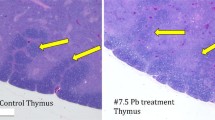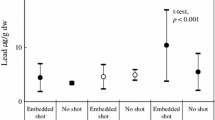Abstract
Lead poisoning of birds of prey from ingestion of ammunition lead has been well documented. Alternative, lead-free ammunition is widely available, but the toxicokinetics of other metals in birds are poorly understood. We tested the erosion of lead, copper, zinc, iron and brass by feeding domestic Pekin ducks (Anas platyrhynchos forma domestica) defined numbers of small metal pellets. The accumulation of these metals was analysed in the breast muscle, brain, pancreas, liver and kidney. Four weeks after application, the ducks were euthanized and necropsied, internal organs tested for metal accumulation and gizzard pellets collected and weighed to record loss by erosion. Degree of erosion was highest in zinc pellets (81% mass loss), followed by iron (46%) and lead (45%) and was only marginal in copper and brass. Only lead showed highly elevated levels of accumulation in organs compared to controls.




Similar content being viewed by others
References
Brewer, L., A. Fairbrother, J. Clark, and D. Amick. 2003. Acute toxicity of lead, steel, and an iron-tungsten-nickel shot to mallard ducks (Anas platyrhynchos). Journal of Wildlife Diseases 39: 638–648.
Clemens, E.T., L. Krook, A.L. Aronson, and C.E. Stevens. 1975. Pathogenesis of lead shot poisoning in the mallard duck. The Cornell Veterinarian 65: 248–285.
Eisler, R. 1998. Copper hazards to fish, wildlife, and invertebrates: a synoptic review. U.S. Geological Survey, Biological Resources Division, Biological Science Report USGS/BRD/BSR–1998-0002. Contaminant Hazard Reviews, Report No. 33, Laurel, Maryland, USA.
Environment Canada. 1993. Toxicity test guidelines for non-toxic shot for hunting migratory birds. Ottawa, Ontario, Canada, 9pp
Fisher, I.J., D.J. Pain, and V.G. Thomas. 2006. A review of lead poisoning from ammunition sources in terrestrial birds. Biological Conservation 131: 421–432.
Finley, M.T., and M.P. Dieter. 1978. Toxicity of experimental lead–iron shot versus commercial lead shot in mallards. Journal of Wildlife Management 42: 32–39.
Franson, J.C., and D.J. Pain. 2011. Lead in birds. In Environmental contaminants in biota. Interpreting tissue concentrations, 2nd ed, ed. W.E. Beyer and J.P. Meador, 563–594. Boca Raton: CRC Press.
French, M.C., C.W. Haines, and J. Cooper. 1987. Investigation into the effects of ingestion of zinc shot by mallard ducks (Anas platyrhynchos). Environmental Pollution 47: 305–314.
Haschke, M., Scholz, W., and U. Theis. 1998. X-Ray Fluorescence in the μm-range using capillary lenses. Proceedings of EDXRF-98, Bologna 1998, 157.
Hooser, S.B. 2012. Iron. In Veterinary toxicology. Basic and clinical principles, 2nd ed, ed. R.C. Gupta, 433–437. Amsterdam: Academic Press.
Jordan, J.S., and F.C. Bellrose. 1950. Shot alloys and lead poisoning in waterfowl. Transactions of the North American Wildlife Conference, San Francisco, California, Wildlife Management Institute, Washington, pp. 155–170.
Kelly, M.E., S.D. Fitzgerald, R.J. Aulerich, R.J. Balander, D.C. Powell, R.L. Stickle, W. Stevens, C. Cray, R.J. Tempelman, and S.J. Bursian. 1998. Acute effects of lead, steel, tungsten-iron, and tungsten polymer shot administered to game-farm mallards. Journal of Wildlife Diseases 34: 673–687.
Krone, O. 2018. Lead poisoning in birds of prey. In Birds of prey: Biology and conservation in the XXI century, ed. J.H. Sarasola, J.M. Grande, and J.J. Negro, 251–272. Berlin: Springer. https://doi.org/10.1007/978-3-319-73745-4.
Levengood, J.M., G.C. Sanderson, W.L. Anderson, G.L. Foley, L.M. Skowron, P.W. Brown, and J.W. Seets. 1999. Acute toxicity of ingested zinc shot to game-farm mallards. Illinois Natural History Survey Bulletin 36: 1–36.
Locke, L.N., N.J. Thomas, and London. 1996. Lead poisoning of waterfowl and raptors. In Noninfectious diseases of wildlife, ed. A. Fairbrother, L.N. Locke, and G.L. Hoff, 108–117. London: Manson.
Mateo, R. 2009. Lead poisoning in wild birds in Europe and the regulations adopted by different countries. In Ingestion of lead from spent ammunition: implications for wildlife and humans, ed. R.T. Watson, M. Fuller, M. Pokras, and W.G. Hunt, 71–98. Boise: The Peregrine Fund.
Meredith, P.A., M.R. Moore, and A. Goldberg. 1977. The effect of calcium on lead absorption in rats. Biochemical Journal 166: 531–537.
Mitchell, R.R., S.D. Fitzgerald, R.J. Aulerich, R.J. Balander, D.C. Powell, R.J. Tempelman, R.L. Stickle, W. Stevens, et al. 2001. Health effects following chronic dosing with tungsten-iron and tungsten-polymer shot in adult game-farm mallards. Journal of Wildlife Diseases 37: 451–458.
Pain, D.J. ed. 1992. Lead poisoning in waterfowl. Proceedings of an IWRB Workshop, Brussels, Belgien, 13–15.Juni 1991, IWRB Special Publication No. 16, IWPB, Slimbridge, UK, 105pp.
Pain, D.J. 1996. Lead in waterfowl. In Environmental contaminants in wildlife–Interpreting tissue concentrations. ed. W.N. Beyer, G.H. Heinz, and A.W. Redmoon-Norwod, 251–264.CRC Press, Boca Raton.
Pain, D.J., I.J. Fisher, and V.G. Thomas. 2009. A global update of lead poisoning in terrestrial birds from ammunition sources. In Ingestion of lead from spent ammunition: implications for wildlife and humans, ed. R.T. Watson, M. Fuller, M. Pokras, and W.G. Hunt, 99–118. The Peregrine Fund: Boise.
Ringelman, J.K., M.W. Miller, and W.F. Andelt. 1993. Effects of ingested tungsten-bismuth-tin shot on captive mallards. Journal of Wildlife Management 57: 725–732.
Scheuhammer, A.M. 1987. The chronic toxicity of aluminium, cadmium, mercury, and lead in birds: a review. Environmental Pollution 46: 263–295.
Scheuhammer, A.M., and S.L. Norris. 1995. A review of the environmental impacts of lead shotshell and lead fishing weights in Canada. Occasional Paper No. 88, 54. Ottawa: Canadian Wildlife Service.
Sileo, L., W.N. Beyer, and R. Mateo. 2004. Pancreatitis in wild zinc-poisoned waterfowl. Avian Pathology 32 : 655–660.
Trinogga, A., G. Fritsch, H. Hofer, and O. Krone. 2013. Are lead-free hunting rifle bullets as effective at killing wildlife as conventional lead bullets? A comparison based on wound size and morphology. Science of the Total Environment 443: 226–232.
USFWS (US Fish and Wildlife service). 2006. Migratory bird hunting approval of tungsten iron-copper-nickel, iron-tungsten-nickel alloy, tungsten-bronze (additional information), and tungsten-iron-tin shot types as non-toxic for hunting waterfowl and coots: availability of environmental assessments. Federal Register 71: 4294–4297.
Wolff, T. 2009. Referenzprobenfreie quantitative Mikro-Röntgenanalyse. BAM-Dissertationsreihe, Band 50, 212pp.
Acknowledgements
We are grateful to Anna Trinogga and Vivien Hoffmann for helping us performing radiographs of the ducks, to Zoltan Mezö, Felix Lackmann and Kirsi Blank for supporting us during the necropsy of the birds and Marion Biering for technical support in the histo-pathological laboratory. We would like to express our gratitude to Karsten Knop and co-workers for taking care of the ducks during the experiment. The project (FKZ 0330720A) was partly funded by the Federal Ministry for Education and Research (BMBF). Finally, we like to thank Bård-Jørgen Bårdsen and Liam Bailey for re-computing the box-plot graphs. We would also like to thank two anonymous reviewers and the guest editor who helped to improve the quality of the manuscript.
Research involving animal rights
The trail of studying the erosion, accumulation and toxicity of the different metals and alloys used as material for hunting ammunition in captive ducks under controlled conditions has been approved by the responsible state agency: Lower-Saxony State Office for Consumer Protection and Food Safety under the registration number 33.11.42502-04-084/07.
Author information
Authors and Affiliations
Corresponding author
Additional information
Publisher's Note
Springer Nature remains neutral with regard to jurisdictional claims in published maps and institutional affiliations.
Rights and permissions
About this article
Cite this article
Krone, O., Kenntner, N., Ebner, N. et al. Comparing erosion and organ accumulation rates of lead and alternative lead-free ammunition fed to captive domestic ducks. Ambio 48, 1065–1071 (2019). https://doi.org/10.1007/s13280-019-01183-0
Received:
Revised:
Accepted:
Published:
Issue Date:
DOI: https://doi.org/10.1007/s13280-019-01183-0




